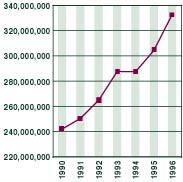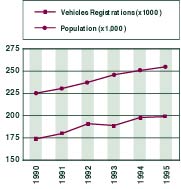|
Indicator Description
Any time you take your car to the market, drop
the kids off at school, or go to the movies, the number of miles
traveled in your vehicle is your VMT. VMT for Boulder County is
aggregated annually by the Boulder County Transportation Department.
VMT includes mils traveled by public transit vehicles.
Why We are Measuring
This
VMT is primarily an indicator of automobile use.
The prevalence of single-occupancy vehicles is largely responsible
for a wide range of unsustainable trends at the local level that
also have global implications. Suburban sprawl, degradation of
air quality, more and more pavement, habitat fragmentation and
destruction and human health problems, not to mention global environmental
change, are all negative trends that are closely related to our
dependence on automobiles.
|

Photo by National Renewable Energy Lab
|


